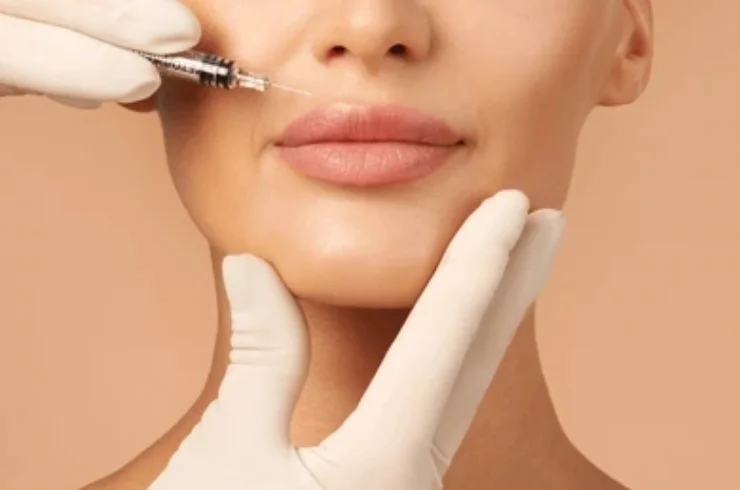How Botox Works:
- Muscle Paralysis: Botox works by blocking the nerve signals that tell muscles to contract. This prevents the muscles from contracting and creating wrinkles.
- Target Areas: Botox is most effective for dynamic wrinkles, which are wrinkles that appear when you make facial expressions. Common treatment areas include:
- Forehead lines: Horizontal lines across the forehead.
- Frown lines (Glabellar lines): Vertical lines between the eyebrows (also known as “11s”).
- Crow’s feet: Wrinkles around the eyes.
Benefits of Botox:
- Wrinkle Reduction: Smooths out dynamic wrinkles, resulting in a more youthful appearance.
- Preventative Measures: Can be used to prevent the formation of new wrinkles.
- Non-Surgical: A minimally invasive procedure with little to no downtime.
- Quick Procedure: The treatment usually takes only a few minutes to administer.
- Reversible: The effects of Botox are temporary, lasting typically 3-6 months.
Risks and Side Effects of Botox:
- Bruising: Minor bruising at the injection site is common.
- Swelling: Temporary swelling may occur.
- Headache: Some patients experience headaches after the procedure.
- Drooping Eyelid (Ptosis): This is a rare but possible side effect, especially when treating the forehead.
- Asymmetry: Uneven results can occur if the Botox is not injected correctly.
- Muscle Weakness: Temporary muscle weakness may occur.
Filler
Fillers, also known as dermal fillers, are injectable substances that add volume to the face and smooth out wrinkles. They are commonly made of hyaluronic acid (HA), a naturally occurring substance in the skin that attracts and retains moisture. Other fillers include calcium hydroxylapatite, poly-L-lactic acid, and polymethylmethacrylate (PMMA).
How Fillers Work:
- Volume Restoration: Fillers add volume to areas where it has been lost due to aging or other factors.
- Wrinkle Smoothing: Fillers plump up wrinkles, making them less noticeable.
- Enhancement: Fillers can be used to enhance features, such as lip augmentation or cheek augmentation.
Target Areas for Fillers:
- Nasolabial folds (smile lines): Lines that run from the nose to the corners of the mouth.
- Marionette lines: Lines that run from the corners of the mouth to the chin.
- Cheek augmentation: Adds volume and definition to the cheeks.
- Lip augmentation: Increases lip volume and shape.
- Under-eye hollows: Fillers can reduce the appearance of dark circles and under-eye bags.
- Chin augmentation: Adds definition to the chin.
Benefits of Fillers:
- Volume Restoration: Replenishes lost volume and restores a more youthful appearance.
- Wrinkle Reduction: Smooths out static wrinkles and fine lines.
- Enhancement: Enhances facial features, such as lips and cheeks.
- Non-Surgical: Minimally invasive with little to no downtime.
- Immediate Results: The effects of fillers are often visible immediately.
- Reversible (HA Fillers): Hyaluronic acid fillers can be dissolved with an enzyme called hyaluronidase if needed.
Risks and Side Effects of Fillers:
- Bruising: Common side effect, can last several days.
- Swelling: Mild to moderate swelling at the injection site.
- Redness: Temporary redness.
- Lumps or Bumps: May develop, can often be massaged away or resolved on their own.
- Infection: Rare but possible.
- Vascular Occlusion: Very rare but serious complication where the filler blocks a blood vessel, potentially leading to tissue damage.
- Allergic Reaction: Possible, especially with non-HA fillers.
Choosing Between Botox and Fillers:
The choice between Botox and fillers depends on the type of wrinkles you want to address and your desired outcome:
- Botox is best for: Dynamic wrinkles caused by muscle movement.
- Fillers are best for: Static wrinkles, volume loss, and enhancing facial features.
Often, Botox and fillers are used in combination to achieve the best results, addressing both dynamic and static wrinkles and restoring overall facial balance.
Important Considerations:
- Consult with a Qualified Practitioner: Choose a board-certified dermatologist or plastic surgeon with experience in both Botox and filler injections.
- Discuss Your Goals: Clearly communicate your desired outcome and expectations with the practitioner.
- Medical History: Inform your practitioner about any medical conditions, allergies, or medications you are taking.
- Realistic Expectations: Understand that the results are temporary and will require maintenance treatments.
- Aftercare Instructions: Follow your practitioner’s post-treatment instructions carefully.
Conclusion:
Botox and fillers are valuable tools for addressing signs of aging and enhancing facial aesthetics. Understanding the differences between these treatments and consulting with a qualified practitioner will help you make informed decisions and achieve the results you desire. Regular maintenance treatments are typically required to maintain the desired effects.
